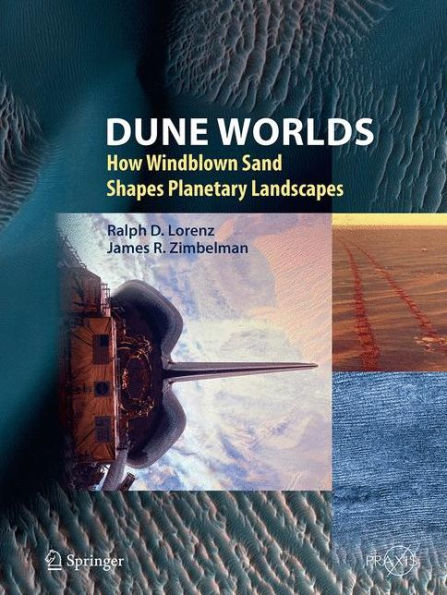The book is divided into 4 parts, the first of which introduces dunes as a planetary phenomenon, showing a landscape reflecting the balance of geological processes – volcanism, impact, tectonics, erosion, deposition of sediments. Dunes are then considered as emergent dynamical systems: the interaction of sand and wind conspires to generate very characteristic and reproducible shapes. Analogies are given with other emergent structures such as patterned ground before the influence of dunes on desert peoples and infrastructure is studied, together with their use as forensic climatological indicators.
Dune Physics is looked at with regard to the mechanics of sand, the physics of wind, saltation – interaction of sand and air – dunes versus ripples and transverse Aeolian ridges, the classification of dune morphology and the sources and sinks of sand. Dune Trafficability considers soil mechanics, effects on mobility on Earth, Mars and elsewhere.
In the second part, Earth, Mars, Titan and other moons and planets are examined, beginning with a survey of the major deserts and dunefields on Earth. The authors then turn to Mars and its environment, sediment type, dune stratigraphy, sediment source and sinks and the association of dunes with topographic features. Titan follows - its thick, cold atmosphere, methane dampness, low gravity, morphology – interaction with topography and the implications of dunes for climate and winds. Dunes elsewhere conclude this part. There are few dunefields on Venus, but there is a .possibility ofAeolian transport on Triton and volcanic-related windstreaks on Io.
The book is divided into 4 parts, the first of which introduces dunes as a planetary phenomenon, showing a landscape reflecting the balance of geological processes – volcanism, impact, tectonics, erosion, deposition of sediments. Dunes are then considered as emergent dynamical systems: the interaction of sand and wind conspires to generate very characteristic and reproducible shapes. Analogies are given with other emergent structures such as patterned ground before the influence of dunes on desert peoples and infrastructure is studied, together with their use as forensic climatological indicators.
Dune Physics is looked at with regard to the mechanics of sand, the physics of wind, saltation – interaction of sand and air – dunes versus ripples and transverse Aeolian ridges, the classification of dune morphology and the sources and sinks of sand. Dune Trafficability considers soil mechanics, effects on mobility on Earth, Mars and elsewhere.
In the second part, Earth, Mars, Titan and other moons and planets are examined, beginning with a survey of the major deserts and dunefields on Earth. The authors then turn to Mars and its environment, sediment type, dune stratigraphy, sediment source and sinks and the association of dunes with topographic features. Titan follows - its thick, cold atmosphere, methane dampness, low gravity, morphology – interaction with topography and the implications of dunes for climate and winds. Dunes elsewhere conclude this part. There are few dunefields on Venus, but there is a .possibility ofAeolian transport on Triton and volcanic-related windstreaks on Io.

Dune Worlds: How Windblown Sand Shapes Planetary Landscapes
308
Dune Worlds: How Windblown Sand Shapes Planetary Landscapes
308Paperback(Softcover reprint of the original 1st ed. 2014)

Product Details
| ISBN-13: | 9783662502280 |
|---|---|
| Publisher: | Springer Berlin Heidelberg |
| Publication date: | 05/07/2015 |
| Series: | Springer Praxis Books |
| Edition description: | Softcover reprint of the original 1st ed. 2014 |
| Pages: | 308 |
| Product dimensions: | 8.27(w) x 10.98(h) x (d) |
